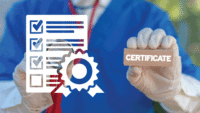Take advantage of your digital footprint to demonstrate your skills and experience.
By Jaime Hannans, PhD, RN, CNE, and Yosemite Olivo, RN
Takeaways:
- Digital identity is the online presence of an individual, including social media presence, profiles and engagement, and any discoverable online content.
- Professional nurses and nursing students should consider what their digital identity says about them.
- A well-developed electronic portfolio can successfully create a positive digital identity by articulating professional goals and experiences, highlighting unique skills sets or achievements, and connecting with other professionals who may lead to new opportunities.


One way to create a positive online presence is by crafting an ePortfolio, which is an online presentation of your academic and professional experiences and achievements. (See Why create an ePortfolio?)
To build your ePortfolio, consider the platform you want to use, how you’ll connect with other nursing professionals, and the content you should include.
Why create an e-Portfolio?
| An ePortfolio, and the process of creating one, offers many benefits to students and nursing professionals. Here are just a few. • For practicing nurses, reflecting on your experiences and skills will help you determine how prepared you are for the positions you’re seeking. • For new graduates, reflecting on clinical and professional growth since admission to a nursing program and outlining short- and long-term goals will aid in building your career path. • In some disciplines, ePortfolios are a well-established practice to demonstrate progress, archive coursework through college, and provide evidence of meeting learning outcomes. • The process of building an ePortfolio can support preparation for academic applications and professional interviews. • Many employers still require traditional résumés, but ePortfolios are an innovative way to share your experiences and skills. |
Platform
Before you start creating your ePortfolio, decide what platform best suits your needs. If you’re a student, your school may offer free access to platforms such as Portfolium or Pathbrite. Reach out to your career services center to find out if these options are available.
Other platform options, for both students and practicing nurses, include social media and sites that allow you to create your own website. LinkedIn, for example, is a social media platform designed specifically for building career profiles and making professional connections. The downside is that it doesn’t allow for design flexibility; your portfolio will look like everyone else’s. No matter which social media platform you use, take advantage of opportunities to connect to professional organizations that align with your career goals.
Another option is creating your own website, using platforms such as WordPress and Google Sites. With your own website, your ePortfolio will be unique in both design and function. Some website-building platforms are easier to use than others, so keep that in mind when making your choice.
Making connections
Networking has always been important to professional growth, and the digital world makes it easy. One way to connect with other nursing professionals is to identify relevant online articles or blogs and share your perspectives on social media. If you’re starting a job search, follow organizations that interest you and interact with them through social media by commenting appropriately on their activities and initiatives.
Content
Recruiters and potential employers will view your ePortfolio in different ways. Some may click one or two links, while others will take time to explore it. You’ll want the content on your ePortfolio to be easily accessible, so that in one click viewers have an immediate representation of you. (See What should be in your ePortfolio?) And whatever platform you use, familiarize yourself with its privacy settings to ensure the security of the information you share.
What should be in your e-portfolio?
| Your ePortfolio should give potential employers a full picture of who you are as a nursing professional, whether you’ve been in practice for years or are a recent graduate. • Provide basic information, including your name, education, certifications, and contact information. |
Professional development
Many advanced-degree programs integrate the development of ePortfolios into coursework, but they can be developed at any career stage. Building an ePortfolio provides opportunities for professional development, critical reflection, and lifelong learning. Digital connections may enhance your knowledge in areas such as healthcare policy, current healthcare trends, and research.
Imagine a potential employer searching your name online and finding information about your academic and professional experiences, your career goals, and your digital connections in your ePortfolio. Isn’t that better than finding random images or posts from social media, or even worse, finding nothing?
Traditional résumés may still be the common method of submission for job applications, but fast-paced technological growth indicates that ePortfolios may soon be required, so why not be ahead of the game?
Jaime Hannans is an assistant professor of nursing, California State University Channel Islands, Camarillo, California. Yosemite Olivo was a student at California State University Channel Islands at the time this article was written.
Selected references
Ainsa T. College students’ digital identity: Perceptions towards employment and career. Coll Stud J. 2016;50(1):47-52.
American Association of Colleges of Nursing. The Essentials of Baccalaureate Education for Professional Nursing Practice. 2008.
Garrett BM, MacPhee M, Jackson C. Evaluation of an eportfolio for the assessment of clinical competence in a baccalaureate nursing program. Nurse Educ Today. 2013;33(10):1207-13.
Karsten K. Using ePortfolio to demonstrate competence in associate degree nursing students. Teach Learn Nurs. 2012;7(1):23-6.
O’Keeffe M, Donnelly R. Exploration of ePortfolios for adding value and deepening student learning in contemporary higher education. Int J ePortfolio. 2013;3(1):1-11.
ant11-Digital Identity-1017a

















